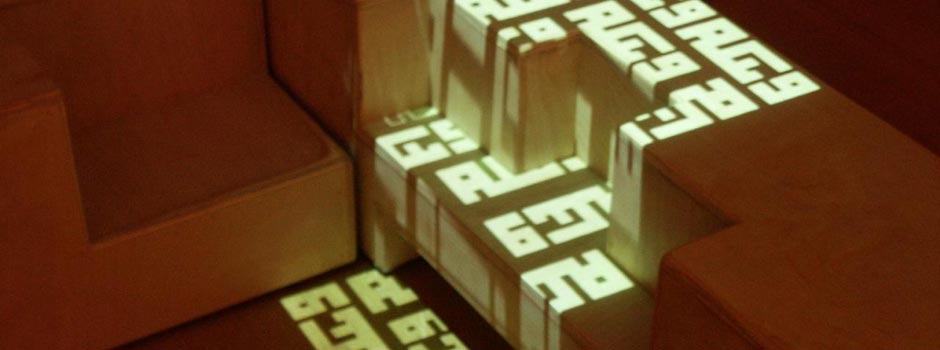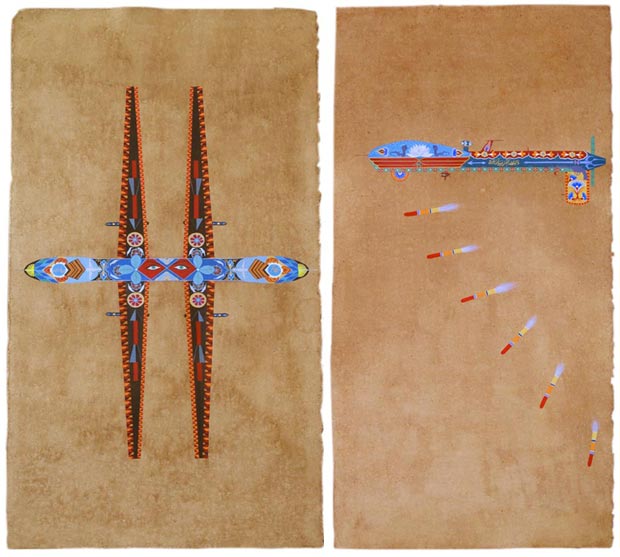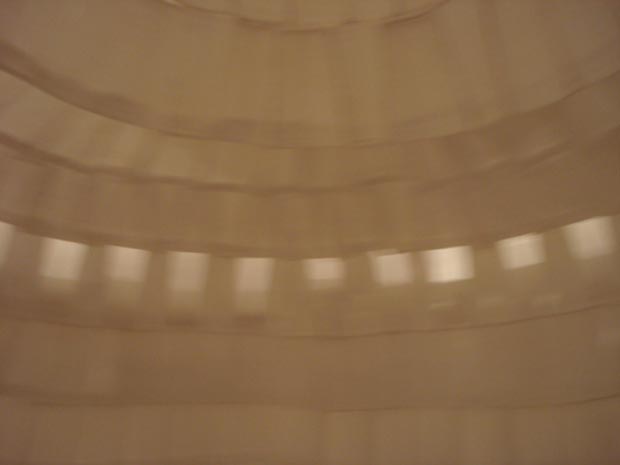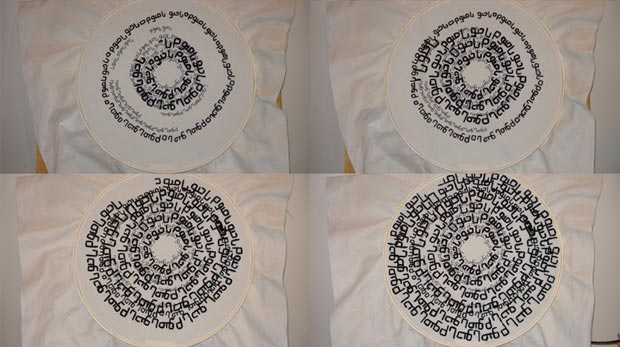
AN INTERVIEW WITH PAKISTANI ARTIST MAHWISH CHISTY Of Drones and Dreams
May 24, 2013 Interview
 Mahwish Chisty / Courtesy of the Artist
Mahwish Chisty / Courtesy of the Artist
I always wanted to be an artist and due to my nature of being detail-oriented, I knew that miniature painting would be the right medium for me as soon as I was introduced to it. The idea of carrying out the old traditions and being connected to the materials has always inspired me.
I had not been back home to Pakistan after moving to the US in 2005 until 2011. My city Lahore is not the same anymore, of course. I saw security guards with large Kalashnikovs out on the streets. Instead of feeling safe, I felt terrified and couldn’t stop wondering about what kind of mess it would be if they ever had to use them. Of course, a very hot topic in Pakistan is the drone program. It’s something that I didn’t hear much about here in the US. Pakistani people feel bitter and angry towards the American government because of their use of drones near the Pakistan-Afghanistan border as it is affecting a lot of civilian lives. I got interested in the topic. And I have always been interested in the local Pakistani folk tradition of ‘truck art’ where truck drivers decorate their vehicle with elaborate colorful imagery that represents their ideas and personalities. By combining the two aesthetics –miniature and folk painting— together, I’m creating loud folk paintings which, at the same time, come out of real and contemporary concerns. I’ve created a series of subjective paintings juxtaposing the stark silhouette of a drone with vibrant cultural imagery to facilitate their acculturation into Pakistani society akin to the military tanks that appear in Afghani war rugs. The main idea behind these paintings, however, is to draw attention to the topic here in US. Like most people, I find this modern warfare disturbingly impersonal where all humanity has been removed and terror hovers over our heads without us even knowing.
 Left: Mahwish Chisty, MQ-9 Guardian, Gouache and tea stain on handmade paper, 8x28 in, 2011 / Right: MQ-9 Predator, Gouache and tea stain on handmade paper, 8x28 in, 2011 / Courtesy of the Artist
Left: Mahwish Chisty, MQ-9 Guardian, Gouache and tea stain on handmade paper, 8x28 in, 2011 / Right: MQ-9 Predator, Gouache and tea stain on handmade paper, 8x28 in, 2011 / Courtesy of the Artist
 Mahwish Chisty, MQ-9/2, Gouache and tea stain on handmade paper, 28.5x8 in, 2011 / Courtesy of the Artist
Mahwish Chisty, MQ-9/2, Gouache and tea stain on handmade paper, 28.5x8 in, 2011 / Courtesy of the Artist
Coming from a Muslim culture, I think everything that I create is political either directly or indirectly. These pieces either explore culture, religion or feminism within a certain realm. I was not consciously thinking about combining high and how tech elements but I think it is a very interesting observation. The choice to move away from painting was more chance-driven. I felt strongly about exploring other contemporary mediums while I was in grad school. Going back to painting was intuitive when I returned from Pakistan in 2011 and felt a strong urge to paint drones.
The concept behind this piece was to create an interactive personal space for individuals to hang out in and make new memories. In my college days, all of my friends would sit around the fountain in the courtyard and share experiences and stories. Through my installations – Sanctuaries I, II & III— I wanted to convert and render these spaces to my own comfort and this project was an extension of that concept. The projection on the floor is a welcome mat that serves a purpose of bringing people closer. Aab-e-Hayaat in Urdu literally means fountain of youth.
_Wood-and-Flash-animation-video-projection_2007_1.jpg) Mahwish Chisty, Aab-e-Hayaat (Fountain of youth), Wood and Flash animation video projection, 2007 / Courtesy of the Artist
Mahwish Chisty, Aab-e-Hayaat (Fountain of youth), Wood and Flash animation video projection, 2007 / Courtesy of the Artist
_Wood-and-Flash-animation-video-projection_2007.jpg) Mahwish Chisty, Aab-e-Hayaat (Fountain of youth), Wood and Flash animation video projection, 2007 / Courtesy of the Artist
Mahwish Chisty, Aab-e-Hayaat (Fountain of youth), Wood and Flash animation video projection, 2007 / Courtesy of the Artist
_Wood-and-Flash-animation-video-projection_2007_7.jpg) Mahwish Chisty, Aab-e-Hayaat (Fountain of youth), Wood and Flash animation video projection, 2007 / Courtesy of the Artist
Mahwish Chisty, Aab-e-Hayaat (Fountain of youth), Wood and Flash animation video projection, 2007 / Courtesy of the Artist
_Wood-and-Flash-animation-video-projection_2007_8.jpg) Mahwish Chisty, Aab-e-Hayaat (Fountain of youth), Wood and Flash animation video projection, 2007 / Courtesy of the Artist
Mahwish Chisty, Aab-e-Hayaat (Fountain of youth), Wood and Flash animation video projection, 2007 / Courtesy of the Artist
Mahwish Chisty, Welcome video, Aab-e-Hayaat (Fountain of youth), Wood and Flash animation video projection, 2007
When I came to United States, I was struggling to find that perfect balance of connecting with my audience. The idea behind using Kufic scripture fascinated me because in this particular font, the Arabic or Urdu alphabets become a visual language. I took it even a step further and started playing with these words so that even if a person is familiar with this language, they still may not understand what is written.
 Mahwish Chisty, Spinning I, DVD video projection, 2008 / Courtesy of the Artist
Mahwish Chisty, Spinning I, DVD video projection, 2008 / Courtesy of the Artist
 Mahwish Chisty, Spinning I-2, DVD video projection, 2008 / Courtesy of the Artist
Mahwish Chisty, Spinning I-2, DVD video projection, 2008 / Courtesy of the Artist
I grew up in Saudi Arabia and I felt like my knowledge of Islam was so limited. I learned in school that music and dance are haram (forbidden) in Islam but then I came to discover that a branch of the same religion celebrates and connects with God using music and dance. A dervish twirls and swirls with the beat of music to a point where everything around him blurs and takes him to a state of mind where he feel more connected to the One. ‘Spinning I’ and ‘Spinning II’ are the two video projects that were created to celebrate and allow the spectator to experience this sensation. ‘Spinning I’ was projected on a large scale to provoke the feeling that you might get after spinning for a while. In this incident, the viewer stays static and by looking at an object spinning, feels dizzy. ‘Spinning II’ on the other hand, has a very different treatment. This stop motion animation video is a patchwork of thousands of pictures that goes in circles and starts to overlap to a point where white canvas becomes black. The text used in this piece refers to a highly celebrated Pakistani Sufi Qawwali singer, Nusrat Fateh Ali Khan. I like the idea of using opposites and seeing how they work together in unison.
 Mahwish Chisty, Spinning II, Stop motion, animation digitally converted to DVD, 2008 / Courtesy of the Artist
Mahwish Chisty, Spinning II, Stop motion, animation digitally converted to DVD, 2008 / Courtesy of the Artist
 Mahwish Chisty, Spinning II-2, Stop motion, animation digitally converted to DVD, 2008 / Courtesy of the Artist
Mahwish Chisty, Spinning II-2, Stop motion, animation digitally converted to DVD, 2008 / Courtesy of the Artist
Mahwish Chisty, Spinning II, Animation digitally converted to DVD, 2008
Expanding on the same concept, I’ve been considering painting a full-scale drone model at some point. I also have few ideas about making an animated video with drone paintings. Moving images are powerful and I want to explore animation on this subject and bring as much attention to this topic as possible. On another note, I will continue to teach painting at George Washington University.
Comments
Add a comment